Inorganic Nanoparticles — Unique Properties and Novel Applications
Professors Mark Asta1, Susan M. Kauzlarich2, Kai Liu3, Alexandra Navrotsky4, 1, Frank E. Osterloh2
1Departments of Chemical Engineering and Materials Science, 2Chemistry, 3Physics, 4Thermochemistry Facility and NEAT ORU, University of California, Davis
Material Matters Volume 2 Issue 1
Introduction
Inorganic particles often exhibit novel physical properties as their size approaches nanometer scale dimensions. For example, the unique electronic and optical properties of nanocrystalline quantum dots may lead to future applications in electrooptic devices and biomedical imaging.1 For many advanced and diverse applications, ranging from chemical sensing to magnetic recording, current research is increasingly focused on exploiting the high surface-to-volume ratios of nanoparticles as a framework for the assembly of complex nanomaterials. Structures including core/shell nanoparticles and multicomponent hierarchical assemblies can exhibit enhanced properties and new functionality arising from the close proximity of chemicallydistinct, nanostructured components. This article highlights the rich variety of structures and properties that can be realized in materials based on inorganic nanoparticles, and points to outstanding fundamental questions raised in controlling these properties. These issues are discussed in the framework of a few illustrative examples for insulating and metallic nanoparticles, taken from the collaborative interdisciplinary research of faculty at UC Davis, interacting through the Nanomaterials in the Environment Agriculture and Technology (NEAT) organized research unit (http://neat.ucdavis.edu).
To fully appreciate the origin of their unique structures and physical properties, it is important to note that nanoparticles are different from bulk materials not just because they are small but also because a large fraction of their volume is within “hailing distance” of the surface (Figure 1). Thus, they can carry “heavy loads” of surface coatings, regions that are structurally and compositionally different from the bulk. These can be rearranged (relaxed) parts of the nanoparticle structure itself, a shell of solid of different composition, or adsorbed layers of water, inorganic or organic molecules. The adsorbed layers can be used as “linkages” to build novel hierarchical structures. The fundamental complexities in structure, bonding, and interfacial interactions between a particle, its coating, and its neighboring environment, can be exploited to derive unique properties for many potential applications.
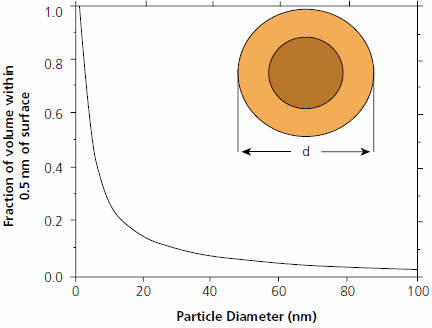
Figure 1. Fraction of volume of a particle of diameter d that lies within 0.5 nm of its surface. The lighter shell represents either that fraction or, alternately, the volume of a 0.5 nm coating on a particle of diameter d=1.5 nm. Figure modified from Ref. 15.
Complex Multi-phase Materials
Consider as a first example the variety of structures and applications associated with oxide nanoparticles. Taking iron oxides and oxyhydroxides as a specific example, the first thing to note is that these materials exist in a rich variety of polymorphs.2 The common anhydrous iron oxide is hematite, a-Fe2O3, a common iron ore and red paint pigment. Magnetite, Fe3O4, is a spinel and forms the basis of numerous magnetic materials and devices, while g-Fe2O3, maghemite, has a defect spinel structure. Oxyhydroxides include goethite, lepidocrocite, akaganeite, ferrihydrite, and green rusts. The oxides and oxyhydroxides often consist of nanoparticles, both in nature and in synthetic materials. Iron oxide particles of various sizes are important as magnetic recording materials, ferrofluids, pigments, corrosion products, and in the transport of nutrients and contaminants (heavy metals and radionuclides) in the environment. The magnetic properties of magnetite and maghemite are also of great interest for biological applications. However, the corrosion sensitivity of magnetite and difficulties in permanently attaching biomolecules to the nanoparticle surface are significant obstacles for such uses. These problems can be overcome by coating the magnetic nanoparticle with a shell, which protects the core from oxidation and corrosion, and additionally, provides a platform for chemical functionalization, thus making the particles potentially bio-compatible. Such core/shell particles can be prepared, for example, by using two successive reverse micelle reactions.3
Core/shell structured magnetic nanoparticles are currently of interest for a wide variety of applications.4 For example, magnetic-core/Au-shell structured nanoparticles, due to the possibility of remote magnetic manipulation, may be used in biological applications for magnetic resonance imaging (MRI), cell tagging and sorting, hyperthermia treatment, and targeted drug delivery.5-7 To date, several different types of magnetic core/shell nanoparticles have been reported, including Fe/Au, Fe3O4/Au, and FeCo/(Au,Ag) nanoparticles.3,8-10 An example of Au-coated Fe nanoparticles is shown in Figure 2.3,5,11,12 Magnetic hard/soft core/shell nanoparticles are another type of technologically important nanostructure. Nanoparticles with high magnetocrystalline anisotropy, such as FePt or CoPt in the L10 phase, may be self-assembled into arrays and used as future generation patterned magnetic recording media with Terabit/in2 density.13 Core/shell structures coupling such magnetic hard phases with magnetic soft (e.g. Fe3Pt) phases may be used to achieve a large energy product for permanent magnet applications.
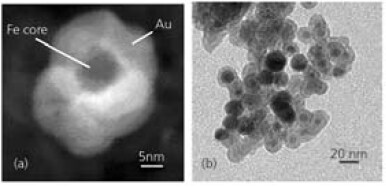
Figure 2.(a) Z-Contrast image of an Au-coated Fe nanoparticle obtained by scanning transmission electron microscopy. (b) Transmission electron microscopy image of Au-coated Fe nanoparticles.
In these areas of research, the core/shell structure, particle size, shape and surface properties are important. For example, for magnetic recording applications using each high-anisotropy magnetic nanoparticle as a single bit, minimal dispersion in the size and shape distributions (<10%) are essential. Iron oxides such as Fe2O3, Fe3O4, and MFe2O4 (M=Fe, Co, Mn) can be prepared as monodisperse surface derivatized nanoparticles.14 Progress has also been made with the production of Co and Fe nanoparticles, as well as nanorods prepared by solution methods. In spite of these advancements and exciting attributes, core/shell structured nanoparticles present enormous synthetic challenges, particularly in terms of the growth mechanisms of the core/shell structures and independent control over core/shell dimensions. Detailed characterization of the core/shell structure, optimization of the core and shell to achieve the desired properties, and their applications in biology or technology are yet to be systematically demonstrated.
Fundamental Chemistry and Physics
The applications above all require understanding of the fundamental physics and chemistry of these complex nanostructures. For example, the competition between surface and bulk contributions to the energy of a particle can lead to the thermodynamic stabilization, at the nanoscale, of crystal structures (polymorphs) that are metastable in the bulk.15-18 This effect can have important consequences for engineering the physical, chemical, electronic, and magnetic properties of these inorganic materials.
Experimental calorimetric studies have provided data on the surface energies and hydration energies of iron oxides and oxyhydroxides.16 Figure 3 shows the enthalpy of various polymorphs relative to an assemblage of coarse hematite plus liquid water at 25 ºC. One sees that goethite becomes energetically stable relative to hematite plus water at surface areas greater than about 15 m2/g (and probably is stable in free energy even at smaller surface areas because of entropy effects). Akaganeite becomes energetically stable relative to hematite plus water at areas greater than 35 m2/g and lepidocrocite at greater than 100 m2/g. Akaganeite becomes stable relative to goethite at surface areas greater than 250 m2/g. It is striking that the slope of the line relating enthalpy and surface area (proportional to surface energy) is much higher for the anhydrous phase hematite than for any of the hydrous phases; this seems to be a general trend also seen in the alumina system.15-19 Furthermore, the more metastable a polymorph is, the lower is its surface energy, a general trend seen not just in the iron oxides but in alumina, titania, and zirconia.15 These complex crossovers in energetics can explain the synthesis and coarsening behavior of iron oxide nanoparticles, both in nature and in the laboratory. The capability of such particles to carry heavy metals such as lead or uranium, or organic pollutants, depends on the crystallographic nature of the particle as well as its surface area. Similarly the magnetic properties depend on phase as well as size.
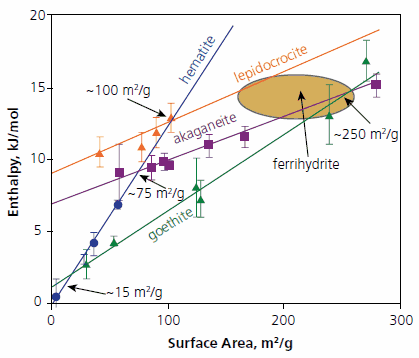
Figure 3. Calorimetrically measured enthalpies relative to coarse hematite plus liquid water ½(Fe2O3 + H2O) for oxyhydroxides and fine grained hematite versus surface area (m2/g). The points are experimental data and the ellipse indicates the range for various ferrihydrte samples studied. Figure summarizes data taken from Refs. 16-18.
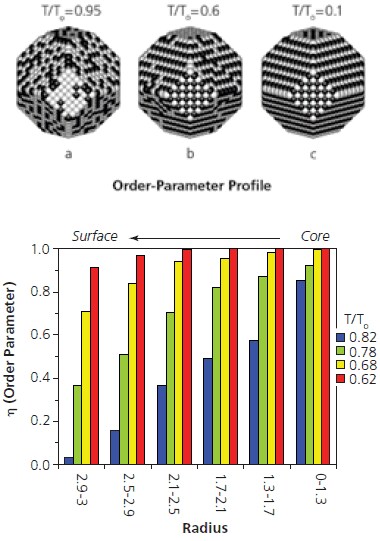
Figure 4. Monte-Carlo simulation snapshots (top) illustrate the nature of the equilibrium atomic ordering transition in Fe-Pt nanoparticles with a characteristic size of 4.79 nm. The lower figure plots order-parameter profiles, as a function of radial distance within the nanoparticle, at different temperatures, illustrating a disordering transition that is surface induced. The top panel is reprinted from Ref. 20, with permission from Elsevier.
In addition to providing the framework for constructing “phase diagrams” to predict equilibrium nanoparticle structures as a function of their size, the measured energetics provide direct benchmarking of computational results for surface structure and energetics. Atomic-scale computer simulations are increasingly used to derive detailed insights into the energetic and kinetic factors governing structural transitions and stability in inorganic nanoparticles. An example is illustrated in Figure 4, taken from recent Monte-Carlo simulations of FePt nanoparticles.20 Due to their anomalously large magnetic anisotropy energies (MAE), and the associated very small critical sizes for superparamagnetism, FePt compounds are considered to be among the most promising candidate materials for future ultra-high-density magnetic recording devices.21 To achieve the high MAE values associated with their bulk counterparts, it is critical to form FePt nanoparticles in their equilibrium tetragonal phase (L10). As synthesized, FePt nanoparticles generally form in the metastable cubic (A1) phase that is magnetically soft, and a post-synthesis annealing step is required to induce formation of the magnetically hard tetragonal phase. Experimental studies have demonstrated a pronounced size dependence of the cubic-tetragonal, order-disorder transition temperature (TO), which is significantly reduced in particles with nanometer-scale diameters.22 Computer simulations suggest that the origin of this effect stems from a surface-induced disordering of the structure, whereby the particle becomes “wetted” by a disordered surface region at temperatures well below the bulk value of TO (Figure 4). The propensity for this surface-induced disordering is significantly affected by the crystalline orientation of the surface facets and the degree of segregation of Fe or Pt onto the particle surface. These findings suggest that surface coatings, as well as control of particle morphology through the synthesis methods described above, are highly effective ways to manipulate the ordering tendencies and stability of the highmagnetic- anisotropy phase down to small particle sizes.
Surface Coatings and Hierarchical Assemblies
Surface coatings also provide a pathway to chemically assemble more complex nanostructures, for example dual-component structures for advanced applications. Examples of discrete dualcomponent structures with potential uses as optical waveguides, magnetic actuators, and chemical sensors are shown in Figure 5.23 In the first example (Figure 5A), magnetite nanoparticles are covalently linked to LiMo3Se3 nanowire bundles to produce ~400 nm long needle-like structures. According to temperature-dependent magnetization measurements, these structures exhibit a magnetic anisotropy along the longer axis that is caused by magnetic dipole interactions between the magnetite nanoparticles. As a result, the structures have the ability to align with weak magnetic fields, and function as nanoscale compasses24 or magnetic actuators. Figure 5B shows a nanostructure composed of gold nanoparticles covalently linked to a colloidal plate made of HCa2Nb3O10. In this configuration, the nanoparticle structure serves as a microscale mirror with the ability to reflect light into discrete directions.25 The red, green and yellow reflections that result from illuminating a sample of these dispersed mirrors with two lasers are shown in the inset. Another type of microscale waveguide is depicted in Figure 5C. Here hexagonal rod-shaped zinc oxide microcrystals serve as supports for covalently attached CdSe nanoparticles.26 The formed microstructure produces a directional emission at the rod ends when illuminated with light in the ultraviolet. This emission arises from the fluorescence of the CdSe quantum dots, and it is waveguided by the ZnO microcrystal. The wavelength of the fluorescence is tunable with the size of the CdSe nanoparticles. Nanostructures in Figures 5B and C should be of interest for spatial light modulators, optical switches, and light-emitting devices. As a final example illustrating potential applications of hybrid multicomponent nanostructures, electrostatically bonded SiO2-Au clusters (Figure 5D) can be used for qualitative and selective nanomolar detection or aliphatic thiols of varying hydrocarbon chain lengths (C2-C18).27 Reaction with the thiols causes a change of the binding between SiO2 and Au particles, which lead to characteristic structural and color changes of the clusters. Because these sensors do not require additional components for signal transduction and processing, the submicrometer-sized clusters are true examples of nanoscale sensors.
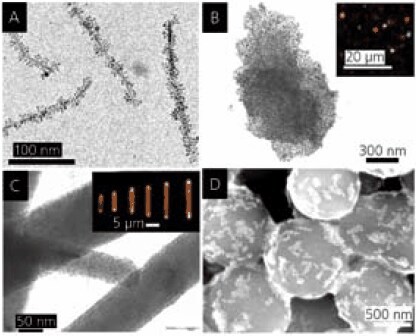
Figure 5. A. LiMo3Se3/Fe3O4 nanocompasses. B. Ca2Nb3O10/Au nanoparticle mirrors (inset: optical micrograph showing reflection). C. ZnO/CdSe light emitters (inset: optical micrograph showing directional fluorescence). D. SiO2/Au thiol sensors (after reaction with dodecanethiol).
The examples above illustrate that structure and properties of materials can change dramatically at the nanoscale, and that these changes can be driven by thermodynamic factors as well as controlled by the kinetics of nanoparticle nucleation and growth. The assembly of complex hierarchical nanostructures, leading to new materials and devices, depends on interactions at the molecular scale, particularly at the surfaces and interfaces of the nanoparticles. Fundamental understanding of these interactions requires a combination of experimental and theoretical techniques, while characterization of the nanostructures formed requires structural analysis (electron microscopy and other methods) and modeling at larger length scales. Driven by the promise of diverse and exciting applications, this field of research offers challenges to develop these methodologies and integrate them into a holistic picture spanning length scales from tenths to thousands of nanometers.
References
如要继续阅读,请登录或创建帐户。
暂无帐户?